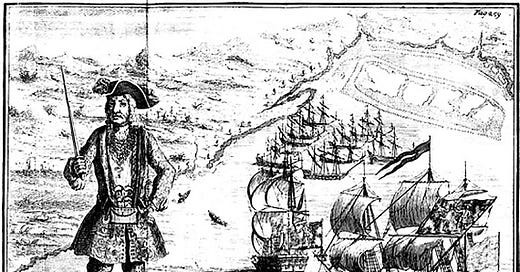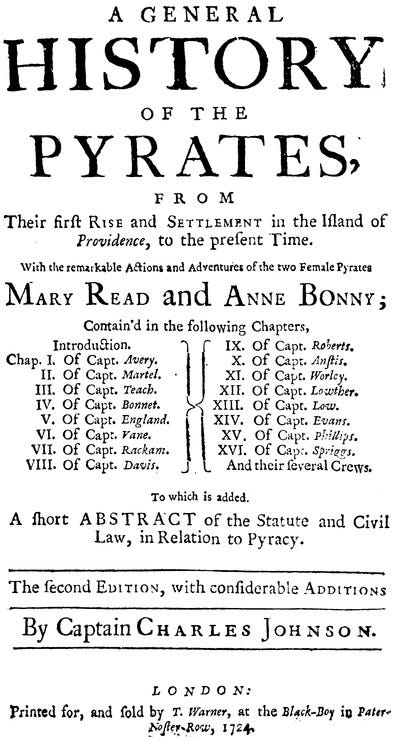Dear Claudius,
Be ye ready to hear th' mysterious tale of th' Pirates o' Madagascar, their way o' life, and how th' astrology behind it all has implications for th' astrology to come? O' course ye be!
In the untamed wilds of Madagascar, where dense verdant jungles stretched out to meet the sea, a band of defiant souls carved out a sanctuary. They called it Libertalia. Here, beneath the towering mountains, they dreamed of a life unfettered by kings and laws, where every man could be his own master. Or so the story goes…
Libertalia, the rumoured utopian pirate colony, emerged from the fertile soils of Madagascar during the Golden Age of Piracy. Whispers on the decks of ships spoke of a pirate haven, a lawless paradise where buccaneers found refuge among the island's lush foliage and sun-kissed sands. They were said to live alongside the Malagasy, creating communities based on a radical notion of freedom, where wealth was shared equally. Yet, the authenticity of this legend is debated, with some historians deeming it more myth than fact. As David Graeber notes in Pirate Enlightenment, or the Real Libertalia:
“To write a definitive history of the pirate implantation in Madagascar is quite impossible. The sources are meager, they consist of little more than narratives written at the time for popular audiences and a handful of court documents, including often laconic accounts of those later arrested for piracy in England or America. When several accounts of the same event exist, they usually contradict one another. The popular accounts are often overtly sensationalistic—however, this does not mean they aren’t true, since clearly a fair number of quite sensational things did happen. Surprisingly little research has been conducted on the Malagasy side. All we have, then, are a series of tiny windows on extraordinary events.”
Extraordinary events call for extraordinary investigative methods: astrology.
Captain Charles Johnson and Misson Implausible
In A General History of the Pyrates (1724), Captain Charles Johnson presents an extensive chronicle of pirates during the Golden Age of Piracy, detailing their exploits on international waters in a mélange of fact and fiction. This has been the primary source of doubt surrounding Libertalia’s legitimacy.
The author himself is a mystery, with many concluding that Captain Charles Johnson was the nom de plume of Daniel Defoe, the author of Robinson Crusoe (1719), a novel that readers at the time believed to be a real-life account of a man cast away on a desert island.
In A General History of the Pyrates, we’re introduced to Captain James Misson, a French nobleman who, disillusioned with the corrupt state of the world, turns to piracy. The story claims that Misson founded Libertalia in 1700, establishing a society built on utopian ideals. However, much like Robinson Crusoe, Misson was fictional.
(Defoe knew that “to spin a yarn” was a nautical expression coined by a sailor, right?)
So, what of the real pirates, then? Those who were judged to have actually existed? To what extent, if any, were they involved in the creation of Libertalia?
Every Alias
Henry Every, Henry Avery, Jack Avery, John Avery, Benjamin Bridgeman, Long Ben… A man of many names, but one sole reputation. Avery was not just any pirate—he was a sailor turned renegade, a first mate on a Spanish warship who, when the owner refused to pay his wages, took matters into his own hands. Rebellion abounded, and Avery and his fellow crew mates chose mutiny, commandeering the warship for good measure. After taking control of the vessel, christened as the Fancy, Avery was elected captain, and they set course for the Cape of Good Hope, South Africa.
Avery and his crew didn’t linger long. Rumour had it that Adam Baldridge, a notorious pirate and shrewd trader, had established a thriving pirate haven on Île Sainte-Marie, Madagascar, back in 1690. Drawn by the promise of riches and refuge, Avery sailed to the island, where he soon crossed paths with another infamous pirate, Thomas Tew. The pair, bound by their shared thirst for adventure and fortune, conspired to pull off one of the most audacious heists ever attempted on the high seas.
On September 7, 1695, Avery and Tew’s crews captured the Fateh Muhammed and Ganj-i-Sawai ships, seizing treasure amounting to £600,000. Needless to say, Mughal Emperor Aurangzeb was incensed and demanded that the British East India Company be held accountable for not taking stronger action to prevent piracy.
While Avery made it back to Madagascar, Tew did not. Tew was killed during the battle for the ships, leaving behind his Malagasy wife, Queen Antavaratra Rahena, and their son, Ratsimilaho (who would eventually reign as king of the Betsimisaraka confederation).
If we examine the astrology of September 7, 1695, we see Neptune in Pisces square Uranus in Gemini. An oceanic calamity inspired by rebellion seems fitting given this energetic combination, but what follows is just as astonishing.
By June of 1696, Avery vanished as suddenly as he had appeared, his reign of piracy lasting a mere two years. Perhaps he had enough treasure to buy himself a new life, but where would the world’s most wanted man go?
The following year, on April 30, 1697, Neptune moved into Aries, and still, no word of Avery was heard.
In 1707, Daniel Defoe (remember him?) published his first piece on Avery. In 1719, another piece on Avery titled The King of Pirates was published and attributed to Defoe. Whether Defoe was captivated by Avery or enchanted by pirate lore is anyone’s guess. However, between Defoe’s works, there is a pamphlet called The Life and Adventures of Capt. John Avery, the Famous English Pirate, (Raised from a Cabin-Boy to a King) Now in Possession of Madagascar, published in London in 1709 by Adrian van Broeck. In the pamphlet, van Broeck asserts that Avery is alive and well, living in Madagascar, and married to none other than the Mughal Emperor Aurangzeb’s daughter.
Who was Adrian van Broeck? Another pseudonymous writer who claimed to have survived captivity by Avery’s crew.
Defoe, van Broeck, and plenty of others may have been experiencing the creative genius of Neptune in Aries and embellishing the Golden Age of Piracy, but one astrological event points to the possibility that Libertalia, or at least the idea of it, was real.
Following the North Star
Nathaniel North was neither a star nor a saint. After narrowly escaping the British navy, he turned to piracy with intense tenacity. Commanding a captured Indian vessel, which contained an Indian crew, the ship’s anchor was lost near Fort Dauphin and drifted into the port of Ambonavola (either modern-day Foulpointe or Fenoarivo), Madagascar, on Christmas Day in 1703.
That night, while the ship was unattended, North approached the remaining Indian crew with a bold suggestion: that they reclaim their vessel and sail back to their homeland. They did precisely that, and at dawn, North chided his own crew for not keeping an eye on the ship. His rebuke was met with laughter, as it was clear to all that North had other ambitions. After a thorough inspection of Ambonavola, he was impressed by its abundant resources—plentiful rice and other essentials made it an ideal refuge. With his intentions set on establishing a stronghold, the crew unanimously elected North as “captain of pirates” in Madagascar.
North established a bustling pirate haven, earning respect as a leader among the people of Ambonavola. As a mediator, he skilfully resolved disputes between local tribes, fostering harmony in the region. Under his leadership, the pirates thrived by cultivating the land, fishing, building homes, and marrying into Malagasy society. However, peace was broken when North's life was abruptly ended by a vengeful local tribe.
All this, according to A General History of the Pyrates. Other sources (linked below) tell slightly different versions of the story, but all seem to agree on North's prominence in Madagascar around 1703, the last time a Saturn-Neptune conjunction occurred in Aries.
Saturn and Neptune in Aries
“As often occurs during Saturn-Neptune alignments, the hidden shadow of past actions and policies become visible, haunting the present... Yet an equally strong expression of the Saturn-Neptune archetypes in combination is the impulse to sustain faith and hope in the darkness… ”
— Cosmos and Psyche, Richard Tarnas
Libertalia offers more than just a historical enigma; the pirates of Madagascar, with their attempt to create a society free from the constraints of their time, echo the leitmotifs of what Saturn and Neptune meeting in Aries might inspire in our own near futures.
While A General History of the Pyrates may have romanticised rebellion, it’s important to remember that a Saturn-Neptune conjunction in Aries suggests not only conflict, but also efforts to enforce idealised visions of social and political change for a new world. As we approach 2026, we may witness a resurgence of individuals ready to fight for both personal and collective freedoms.
The pirates of Libertalia, whether real or legendary, may have been a product of their time, but their stories remind us of the enduring power of vision and the willingness to fight for a freer world. Perhaps we might find ourselves inspired to establish our own paths to self-governance, creating new meanings of what it means to be truly liberated in our age.
Yours ever in awe,
Sam
Additional resources:
The Wandering Pirate: Nathaniel North (Echoes of History)
Enlightenment From Below: Pirates and radical democracy in Madagascar
Pirate Enlightenment, or the Real Libertalia by David Graeber review – utopia by the sea
The Fascinating History of the Legendary Pirate Haven: Libertalia
The Pirate Cemetery: Madagascar (The map discovery from 1733… note Saturn’s return to Aries)






A curious piece to read in the beginning of 2025! Loved the way you saw Saturn Neptune in Aries reflected historically here.
What a great piece! So evocative. 👏